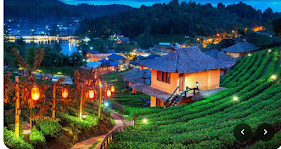Albarracín, Spain
Albarracín is surrounded by stony
hills and the town was declared a Monumento Nacional in 1961. The many red
sandstone boulders and cliffs surrounding Albarracín make it a popular rock-climbing
location, particularly for boulderers. The former capital of a Taifa kingdom,
Albarracín has preserved all its Islamic and medieval flavor.
The Bastion and the Andador Tower date from the 10th century. In
the 11th century,
the Taifa kings of Albarracín built the walls surrounding the Engarrada suburb.
Finally, after
the Reconquest, the Christian lords and the kings of Aragon
erected new sections of walls and most of the forts and towers that remain today.
The steep streets, including the
Plaza Mayor, are particularly remarkable. It houses the town hall, which offers
an impressive viewpoint over the Guadalaviar River.
The present-day Cathedral of El Salvador,
attached to the former Episcopal Palace, was built in the 16th century.
The Diocesan Museum, located in the
palace, exhibits a valuable collection of Flemish tapestries. In addition,
throughout the Albarracín Cultural Park, you can see
samples of post-Palaeolithic art from between 6000 and 1000 BC. The Roman
period is the one from which most remains have been preserved, including the
18-kilometre aqueduct that ran from Albarracín to Cella.
The places to visit are:
--Albarracín Diocesan Museum
A collection of religious
art. It is located in the old, noble rooms of the
Episcopal Palace, adjacent to the Cathedral. The museum has interesting pieces of religious
art, including paintings, sculptures, precious metalwork, and musical
instruments, as well as textiles from the 14th-18th centuries.
--Prado del Navazo Shelter
Prehistoric traces. It is part
of the Rock Art of the Mediterranean Basin of the Iberian Peninsula and a
UNESCO World Heritage site. They belong to the exceptional group of
the Albarracín rock paintings,
--Trebuchet Park
Belmonte Castle houses this theme park dedicated to reproductions of the
siege machines used by armies to attack strongholds. It contains items ranging
from the 9th century BC to the 15th century, and from various cultures
including the Neo-Assyrian and Greek, and from the Roman Empire, Byzantium,
Muslim, Christian, and the Orient.
😊😊😊😊 😊😊
😊😊 😊😊 😊😊 😊😊 😊😊
😊😊 😊😊 😊😊 😊😊 😊😊
😊😊





Comments
Post a Comment